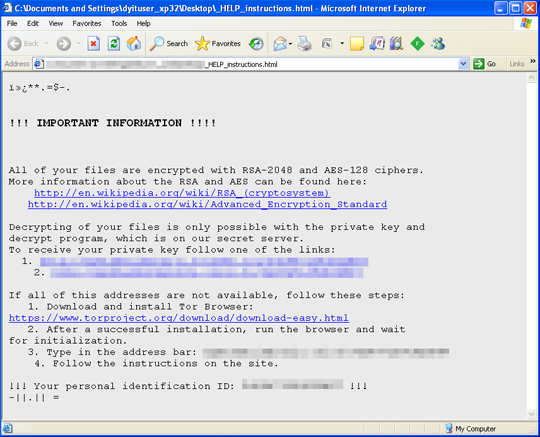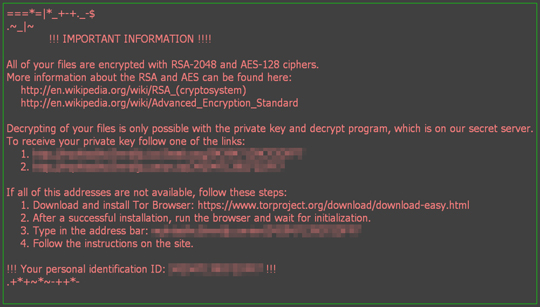RANSOM_LOCKY.DLDSW
Ransom:Win32/Locky!rfn (Microsoft); Ransom.Locky (Malwarebytes); Trojan.Cryptolocker.AF (Symantec)
Windows


Threat Type: Trojan
Destructiveness: No
Encrypted:
In the wild: Yes
OVERVIEW
This Trojan arrives on a system as a file dropped by other malware or as a file downloaded unknowingly by users when visiting malicious sites.
It connects to certain websites to send and receive information. It gathers information and reports it to its servers.
TECHNICAL DETAILS
Arrival Details
This Trojan arrives on a system as a file dropped by other malware or as a file downloaded unknowingly by users when visiting malicious sites.
Installation
This Trojan drops the following files:
- {folders containing encrypted files}\_{count of dropped note per folder}_HELP_instructions.html - ransom note
It drops and executes the following files:
- %Desktop%\_HELP_instructions.html - ransom note
- %Desktop%\_HELP_instructions.bmp - image used as wallpaper
(Note: %Desktop% is the desktop folder, where it usually is C:\Documents and Settings\{user name}\Desktop in Windows 2000, Windows Server 2003, and Windows XP (32- and 64-bit); C:\Users\{user name}\Desktop in Windows Vista (32- and 64-bit), Windows 7 (32- and 64-bit), Windows 8 (32- and 64-bit), Windows 8.1 (32- and 64-bit), Windows Server 2008, and Windows Server 2012.)
Other System Modifications
This Trojan modifies the following file(s):
- It encrypts files in fixed, removable and RAM disk drives.
- It renames the encrypted files to {unique ID per victim}-{identifier}.zepto
It adds the following registry entries as part of its installation routine:
HKEY_CURRENT_USER\Control Panel\Desktop
Wallpaper = %Desktop%\_HELP_instructions.bmp
It sets the system's desktop wallpaper to the following image:
Other Details
This Trojan connects to the following website to send and receive information:
- http://{BLOCKED}.{BLOCKED}.59.147/upload/_dispatch.php
- {Domain Generated Algorithm}.{ru, info, biz, clicksu, work, pl, org, pw, xyz}/upload/_dispatch.php
It encrypts files with the following extensions:
- .001
- .002
- .003
- .004
- .005
- .006
- .007
- .008
- .009
- .01
- .011
- .123
- .602
- .3dm
- .3ds
- .3g2
- .3gp
- .7z
- .aes
- .apk
- .ARC
- .asc
- .asf
- .asm
- .asp
- .asset
- .avi
- .bak
- .bat
- .bik
- .bmp
- .brd
- .bsa
- .bz2
- .c
- .cgm
- .class
- .cmd
- .cpp
- .crt
- .cs
- .csr
- .CSV
- .d3dbsp
- .das
- .db
- .dbf
- .dch
- .dif
- .dip
- .djv
- .djvu
- .DOC
- .docb
- .docm
- .docx
- .DOT
- .dotm
- .dotx
- .fla
- .flv
- .forge
- .frm
- .gif
- .gpg
- .gz
- .h
- .hwp
- .ibd
- .iwi
- .jar
- .java
- .jpeg
- .jpg
- .js
- .key
- .lay
- .lay6
- .lbf
- .ldf
- .litemod
- .litesql
- .ltx
- .m3u
- .m4a
- .m4u
- .max
- .mdb
- .mdf
- .mid
- .mkv
- .mml
- .mov
- .mp3
- .mp4
- .mpeg
- .mpg
- .ms11
- .MYD
- .MYI
- .n64
- .NEF
- .odb
- .odg
- .odp
- .ods
- .odt
- .onetoc2
- .otg
- .otp
- .ots
- .ott
- .p12
- .PAQ
- .pas
- .pem
- .php
- .pl
- .png
- .pot
- .potm
- .potx
- .ppam
- .pps
- .ppsm
- .ppsx
- .PPT
- .pptm
- .pptx
- .psd
- .pst
- .qcow2
- .rar
- .raw
- .rb
- .re4
- .RTF
- .sav
- .sch
- .sh
- .sldm
- .sldx
- .slk
- .sql
- .SQLITE3
- .SQLITEDB
- .stc
- .std
- .sti
- .stw
- .svg
- .swf
- .sxc
- .sxd
- .sxi
- .sxm
- .sxw
- .tar
- .tar
- .tbk
- .tgz
- .tif
- .tiff
- .txt
- .uop
- .uot
- .upk
- .vb
- .vbs
- .vdi
- .vmdk
- .vmx
- .vob
- .wallet
- .wav
- .wb2
- .wk1
- .wks
- .wma
- .wmv
- .xlc
- .xlm
- .XLS
- .xlsb
- .xlsm
- .xlsx
- .xlt
- .xltm
- .xltx
- .xlw
- .xml
- .zip
- wallet.dat
It does the following:
- It prevents encrypting files containing any of the strings in its full path name:
- $Recycle.Bin
- AppData
- Application Data
- Boot
- Program Files
- System Volume Information
- Temp
- Thumbs.db
- Windows
- winnt
- It deletes shadow copies by executing the following command:
- vssadmin.exe Delete Shadows /Quiet /All
- It requires a specific argument in order to perform its intended routine (ie. 321, 123, 65, etc).
- It deletes itself after encrypting the files.
It gathers the following information and reports it to its servers:
- Language of affected system
- number of failed encrypted files
- number of encrypted files
- OS architecture (if 64bit)
- victim ID
NOTES:
This ransomware uses the following ransom note:

SOLUTION
Step 1
Before doing any scans, Windows XP, Windows Vista, and Windows 7 users must disable System Restore to allow full scanning of their computers.
Step 2
Note that not all files, folders, and registry keys and entries are installed on your computer during this malware's/spyware's/grayware's execution. This may be due to incomplete installation or other operating system conditions. If you do not find the same files/folders/registry information, please proceed to the next step.
Step 3
Restart in Safe Mode
Step 4
Delete this registry value
Important: Editing the Windows Registry incorrectly can lead to irreversible system malfunction. Please do this step only if you know how or you can ask assistance from your system administrator. Else, check this Microsoft article first before modifying your computer's registry.
- In HKEY_CURRENT_USER\Control Panel\Desktop
- Wallpaper = %Desktop%\_HELP_instructions.bmp
- Wallpaper = %Desktop%\_HELP_instructions.bmp
Step 5
Search and delete these files
- {folders containing encrypted files}\_{count of dropped note per folder}_HELP_instructions.html
- %Desktop%\_HELP_instructions.html
- %Desktop%\_HELP_instructions.bmp
Step 6
Restart in normal mode and scan your computer with your Trend Micro product for files detected as RANSOM_LOCKY.DLDSW. If the detected files have already been cleaned, deleted, or quarantined by your Trend Micro product, no further step is required. You may opt to simply delete the quarantined files. Please check this Knowledge Base page for more information.
Step 7
Restore encrypted files from backup.
Did this description help? Tell us how we did.



